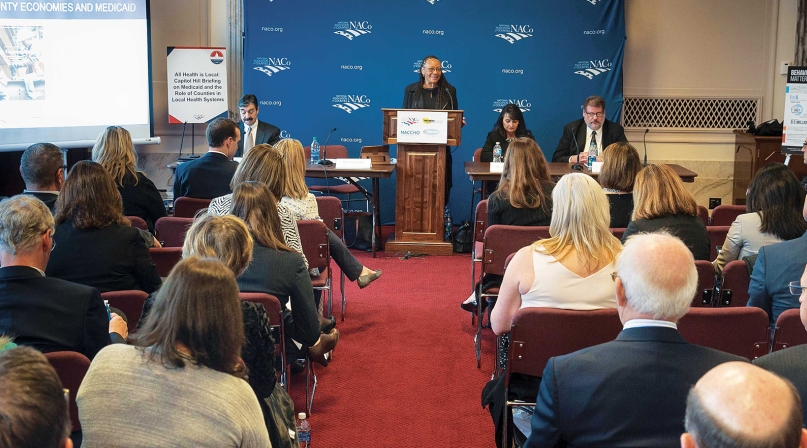Several sessions track the changing healthcare landscape for counties
Author
Upcoming Events
Related News

Bryan Desloge: U.S. healthcare system is fast and effective but costs trickle down to counties
Counties can’t control the national healthcare debate, but local governments can help improve their community’s health outside the healthcare system through public efforts.
“Healthcare is complex. It’s more than just the attention of healthcare practitioners and the providers or insurers,” said Toni Carter, a Ramsey County (Minn.) commissioner who chairs the NACo Healthy County Initiatives Advisory Board.
“Each one of us out in our counties deserves the opportunity to be healthy. And we know that health is largely about the conditions for health and well-being.”
As the state of healthcare changes under the Trump administration, much of the future of healthcare depends upon how local governments use their limited resources. Since then-President Barack Obama signed the Affordable Care Act (ACA) into law in 2010, citizens have relied on government-mandated health coverage. Now as the Trump administration works with Congress to repeal the ACA, counties will be left to deal with the repercussions.
While speaking with county leaders at the 2017 NACo Legislative Conference, NACo President Bryan Desloge explained that while the American healthcare system excels at both speedy delivery and quality care, it struggles with maintaining costs, and this is what will trickle down to counties.
“We are the people on the local level who deliver services,” Desloge told county leaders, noting that the federal government often sets their financial ability to provide healthcare services. “So we have to pay close attention to where this [administration] goes.”
Sen. Amy Klobuchar (D-Minn.), echoed Desloge’s warning in her keynote speech to county officials at the conference, warning that county commissioners should be very concerned about federal healthcare reform proposals that will inevitably “land in the counties’ laps.”
“This really isn’t a joke,” Klobuchar said. “Sometimes laws can pass without anyone noticing and then there is a big effect on the local level. As we go through this tumultuous time, we need to be thinking about people in counties and how this all works in local government.”
Unfortunately, there isn’t one central system to keep track of the changes in healthcare, and this can hurt local governments’ capacities to provide efficient care, she said.
Even though state and federal government dictate much of a county’s ability to hold down costs, there are still incremental ways in which counties can take cost-cutting actions.
Counties can lower drug prices through pharmacy management, smart buying and looking where doctors are overprescribing certain medications. But in addition to lowering the cost of healthcare, counties can also work to lower risk factors for illness through public health initiatives.
Social factors and public efforts to impact healthcare play as much a role in keeping communities healthy as doctors and hospitals do, said Dr. Umair Shah, executive director of the Harris County (Texas) Public Health department and vice president of the National Association of County and City Health Officials.
Public health is when “we work together as a society to assure the conditions in which people can be healthy,” Shah told county officials.
Public health initiatives also work to recognize and alleviate the social and economic conditions that impact health and the vitality of communities, he noted.
This may mean building more public parks, increasing access to healthy foods or supporting children’s sports teams, he said. Counties should try to involve as much of the community as they can in their public health efforts, whether that means collaborating with schools, the police force or the private sector, he noted.
“It’s not just what happens in the hospital,” Shah explained. “It’s what we do in the community.” For example, if a doctor tells an obese patient to lose weight, the number of public parks, trails, and access to healthy food in the patient’s community could help determine his or her success, he said.
Today, only 3 percent to 4 percent of healthcare spending goes toward public health initiatives, while the rest goes to the hospital system and treating diseases, he said, noting that this reactive healthcare system helps cure diseases, but does nothing to prevent them.
Shah encouraged leaders to focus on public health efforts, and not to abandon these efforts once a public health crisis — the Zika virus, for example — subsides.
Investing in public health alternatives may cost counties more in the short-term, but it would lower healthcare spending in the long run, he said.
“When we do our jobs [in public health] it is largely invisible,” Shah explained.
“So I always see public health as the offensive line of a football team,” he said.
“At the end of the day, nobody’s going to say that Tom Brady’s success at the Super Bowl in Houston was not because of Tom Brady, but because his offensive line made sure he had time to throw those passes.
So that’s why it’s really important for us to think about what public health does.”
Communities with stronger economies are much more likely to offer activities that help their communities’ overall health than poorer communities and this creates a health disparity between communities, Shah said.
In order to create “health equity communities,” he said, local officials should focus on economic development, education, creating a healthier environment and community engagement.
Attachments
Related News

USDA and HHS release new dietary guidelines
On January 7, U.S. Department of Agriculture Secretary Brooke Rollins and U.S. Department of Health and Human Services Secretary Robert F. Kennedy, Jr. unveiled the new Dietary Guidelines for Americans, 2025–2030.

SAMHSA cancels, reinstates thousands of behavioral health grants
Late on Wednesday, January 14, the Administration announced that thousands of Substance Abuse and Mental Health Services Administration (SAMHSA) grants that had been terminated just one day earlier would be reinstated.

House passes three-year extension of ACA Enhanced Premium Tax Credits
On January 8, the U.S. House of Representatives passed legislation to extend enhanced Affordable Care Act (ACA) premium tax credits (EPTCs) for three years, sending the measure to the Senate as lawmakers work to negotiate a bipartisan compromise.